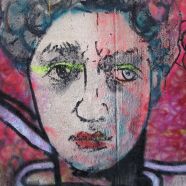
Graffiti at Sitt Naguiba’s Garage, downtown Cairo. Artist: Sad Panda
Share This
Print This
Email This
Portfolio: Photographs
- Graffiti at Sitt Naguiba’s Garage. Artist: Tefa
- Graffiti at Sitt Naguiba’s Garage, downtown Cairo. Artists: Salma Abed and Nada Elissa
- Graffiti at the Boursa wall, downtown Cairo. Artist: Enas Awad
- Graffiti at Sitt Naguiba’s Garage, downtown Cairo. Artist: SAM 901
- Graffiti at Sitt Naguiba’s Garage, downtown Cairo. Artists: Ahmed Nour, Nour Shoukry and Sad Panda
- Graffiti at Sitt Naguiba’s Garage, downtown Cairo. Artist: Sad Panda
- Graffiti at Sitt Naguiba’s Garage, downtown Cairo. Artist: Osama El Samhaa
- Graffiti at the Boursa wall, downtown Cairo. Calligraphy: Maamoun ElZaem Art: Carolina Falkholt
- Graffiti at the Boursa wall, downtown Cairo. Artist: Khadiga El Gawas
Women on Walls (WOW), or Sit El 7eta (in Arabic), began as an idea to see how we can use graffiti and street art in a project that combines the creativity and uniqueness of Egypt’s top graffiti, street, and visual artists to work on a national campaign focusing on women’s empowerment. A proposal was submitted to CKU (Center for Culture and Development, Denmark) and within a few weeks, funding was approved for this project. We spent most of January and February 2014 looking, speaking, and meeting with artists from various cities and from different fields to have them join us.
WOW has since grown to more than a small street art campaign. We are using art to discuss one of the most important topics in Egypt, women’s empowerment, which involves many different issues, including the political, the social, the economic, and the cultural. The project has been set up in a way to allow for the very different approaches and techniques and characters of each of the artists to develop and grow.
And so here we are today: a core group of more than sixty street, graffiti, and visual artists working together in the street in four different cities; a small group of young film directors following the entire process; and a slightly bigger group of musicians creating and/or donating songs to the project. What began as a campaign for women’s empowerment has grown to become an experimental artistic platform for all kinds of artists to come together and produce an artistic collage in the street, in film, and in music.
Images (in order of appearance):
Graffiti at Sitt Naguiba’s Garage by Tefa
The female suffers a great deal in Arab societies. This piece illustrates the struggles of the female as she covers her eyes with her hands, on the back of which is written “freedom.”
Graffiti at Sitt Naguiba’s Garage, downtown Cairo by Salma Abed and Nada Elissa
Nada, who made the spider-woman, says this about the piece:
“I am a human before anything else . . . I don’t know whether this creature that I have drawn is male or female. It is composed of human head and the body of a spider. Are we not all victims? Whether male or female? My message is not for females only, but for all humans who feel that they have been transformed into something, or into a weird creature, that is controlled.”
Graffiti at the Boursa wall, downtown Cairo by Enas Awad
Enas says this about the piece:
“The two sides of a female: the split face reflects the alternating roles of the Egyptian female. The first half of the face reflects the Pharaonic female who ruled one of the strongest and greatest civilizations in history; and as time passed, there appeared the second half, especially in the eyes of society—the female that is restricted, has no equal rights to participation in society and in the workforce. This side of the female has been forced to retreat from society, by society, as is reflected in her uncertain features beneath layers of clothing. She is treated as though it was shameful to have been born female.”
Graffiti at Sitt Naguiba’s Garage, downtown Cairo by SAM 901
A free woman; a female in her most beautiful of states.
Graffiti at Sitt Naguiba’s Garage, downtown Cairo by Ahmed Nour, Nour Shoukry and Sad Panda (2 images included)
Both sexes are strangulated by the society’s perception on what’s male and female. When you take a close look at this graffiti piece, you will see that the man smoking sheesha watching a woman, while the tube to the sheesha is holding everybody in its grip, like a boa constrictor; a harassment that is affecting the woman even when she has entered the private space of her home.
Graffiti at Sitt Naguiba’s Garage, downtown Cairo by Osama El Samhaa
Guevariyya, I love you as a rebel.
The art piece reflects the idea that the voice of the revolutionary female is not forbidden.
Graffiti at the Boursa wall, downtown Cairo by Maamoun ElZaem (Calligraphy) and Carolina Falkholt (Art)
Carolina Falkholt says this about the piece:
“This is, on many levels, a conceptual artwork. It is an act of resistance. An attempt to employ the destruction of patriarchy in public space. This drawing is the top layer of a process where I and my fellow artists as a first step discussed the sexist language used toward women, words which we then wrote on a white wall in order to destroy them by crossing them out with layers of paint. The motif, which actually is less important than the act in itself, serves more as a memory of our protest on a street level.”
Graffiti at the Boursa wall, downtown Cairo by Khadiga El Gawas
The calligraphy around the eye says: “Your eye doesn’t own me.” The females in Egypt are constantly judged, classified, commented on, or in the worst case, harassed while they are moving around in the public space.







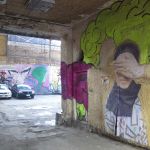
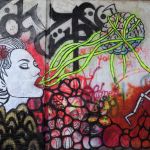
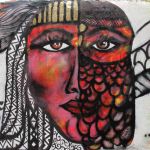

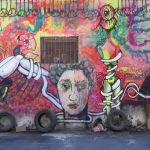
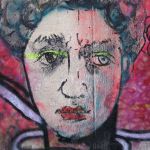
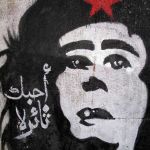
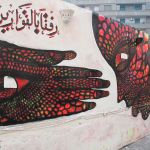
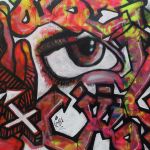
Hello, due to my interest in the graffiti in the streets of Cairo, I’ve decided to write a research paper on the significance of the Graffiti on the walls of Cairo on reflecting the Egyptian people’s sociopolitical experiences.
I would really appreciate it if I could make some contact with any of the artists of the analysts of the art for it would be very helpful.
Thank you.